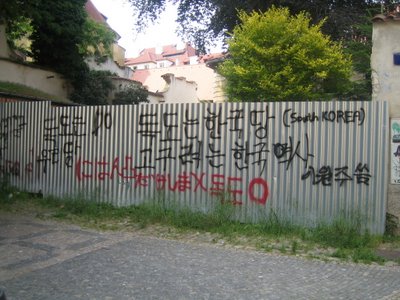a postscript to last week's discussion
 I meant to post this picture last week when we were talking about territorial expansion, but I forgot. I studied abroad last year, and while traveling in Prague, I came across some interesting graffiti. The things in black can be roughly translated to "Dokdo is our land," "Dokdo is South Korean land," "Koguryo is Korean history," and I'm guessing that's a signature at the bottom right (anyone can correct me if I'm wrong. I haven't studied Korean language in a while.). The red stuff says (in Japanese) "Japan" (I think, although this is spelled wrong then), "Takeshima" (is this the correct spelling in Japanese?), "X," (in Korean) "Dokdo," and "O."
I meant to post this picture last week when we were talking about territorial expansion, but I forgot. I studied abroad last year, and while traveling in Prague, I came across some interesting graffiti. The things in black can be roughly translated to "Dokdo is our land," "Dokdo is South Korean land," "Koguryo is Korean history," and I'm guessing that's a signature at the bottom right (anyone can correct me if I'm wrong. I haven't studied Korean language in a while.). The red stuff says (in Japanese) "Japan" (I think, although this is spelled wrong then), "Takeshima" (is this the correct spelling in Japanese?), "X," (in Korean) "Dokdo," and "O."I recall giggling when I first saw this because it was so, so random and seemingly out of place. But, there were many Korean tourists in Prague, which is not true of many of the places I travelled to (except Istanbul. There were tons of Koreans in Istanbul, and the Turkish could actually figure out my ethnicity instead of assuming I was Chinese or Japanese, but I'm digressing...). It seems that the upsurge in tourism to the Czech Republic is the direct result of the popularity of the drama Lovers in Prague (which I have not seen). There also seems to be increased Korean investment in the Czech Republic. But, what to make of the graffiti? I thought it was a nice example of the intersection of Korean cultural and commerical expansion. Koreans could claim a space even outside of Korea to voice nationalistic sentiments, even on vacation (an example of the paradoxical Korean globalization?).

0 Comments:
Post a Comment
<< Home